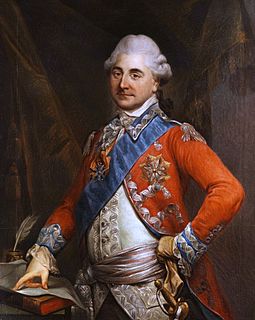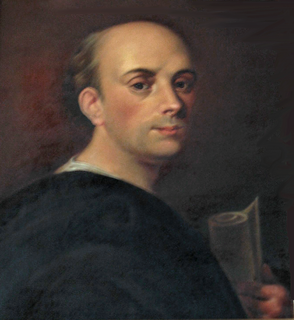Jakub Plichta | |
|---|---|
 | |
| Coat of arms | Półkozic |
| Died | 7 February 1407 in Wilno |
Jakub Plichta (died 7 February 1407) was a Catholic priest and the second bishop of Vilnius.
Jakub Plichta | |
|---|---|
 | |
| Coat of arms | Półkozic |
| Died | 7 February 1407 in Wilno |
Jakub Plichta (died 7 February 1407) was a Catholic priest and the second bishop of Vilnius.

Stanisław August Poniatowski, known by his regal title Stanislaus II Augustus, was King of Poland and Grand Duke of Lithuania from 1764 to 1795, and the last monarch of the Polish–Lithuanian Commonwealth.

Stanisław Wawrzyniec Staszic was a leading figure in the Polish Enlightenment: a Catholic priest, philosopher, geologist, writer, poet, translator and statesman. A physiocrat, monist, pan-Slavist and laissez-fairist, he supported many reforms in Poland. He is particularly remembered for his political writings during the "Great (Four-Year) Sejm" (1788–92) and for his large support towards the Constitution of 3 May 1791, adopted by that Sejm.

Count Roman Ignacy Potocki, generally known as Ignacy Potocki, was a Polish nobleman, member of the influential magnate Potocki family, owner of Klementowice and Olesin, a politician, writer, and office holder. He was the Marshal of the Permanent Council in 1778–1782, Grand Clerk of Lithuania from 1773, Court Marshal of Lithuania from 1783, Grand Marshal of Lithuania from 16 April 1791 to 1794.
Stanisław of Skarbimierz was the first rector of the University of Krakow. He was the author of Sermones sapientiales, comprising 113 sermons.

Antoni Barnaba Jabłonowski (1732–1799) was a Polish noble (szlachcic) and political activist.

Scipione Piattoli was an Italian Catholic priest—a Piarist—an educator, writer, and political activist, and a major figure of the Enlightenment in Poland. After ten years as a professor at the University of Modena in Italy, he emigrated to the Polish–Lithuanian Commonwealth, where he became associated with several magnate families—the Potockis, Lubomirskis, and Czartoryskis. He was a member of Duchess Dorothea von Medem's court in Courland (Lithuania) and of King Stanisław August Poniatowski's court.
Czesław Czypicki (1855-1926) was a Polish lawyer from Kożmin, activist for the singers societies. His father was a forester. After graduating from a Junior High School in Braniewo, he studied law in Wroclaw. He did his internship in a court in Jastrowie, and then settled in Koźmin Wielkopolski.

Janusz Suchywilk of Grzymala Coat of Arms was a Polish nobleman (szlachcic), relative of Jarosław z Bogorii i Skotnik.

Piotr Gamrat of Sulima arms was Archbishop of Gniezno and Primate of Poland.

Janusz Kiszka was a Polish politician and magnate in the 17th century Polish–Lithuanian Commonwealth. Last of the Kiszka family. Royal Rotmistrz, starosta of Parnawa from 1610, Voivode of Polock since 1621, Field Lithuanian Hetman since 1635, Great Lithuanian Hetman since 1646.

Paweł Holszański was a notable Catholic church official and one of the last male scions of the once-mighty Lithuanian Olshanski princely family of the Grand Duchy of Lithuania.

Krzysztof Boguszewski of Clan Ostoja was a Polish Baroque painter.
Teofil Adamecki was a Polish lawyer and activist.

Jerzy Tyszkiewicz was auxiliary bishop of Vilnius from 1627 to 1633, bishop of Samogitia from 1633 to 1649, and bishop of Vilnius from 1649 to 1656.

Bishop Florian Laskary z Kościelca was Bishop of Płock, Poland from 1317 until his death in 1333 AD, He was also Canon of Duke Bolesław II and a chaplain at Gniezno.
Bishop Gedko II was Bishop of Płock, Poland from 1294 until his death in 1296 AD. He is also known as Gosław.
Andrzej Gryfita was the Bishop of Płock in Poland from 1239 until his death in 1244 AD. He was also known as Andrew of Brzeźnica.
Bernard was a 14th-century bishop, Dominican friar and confessor of Pope Innocent VI.
Józef Bielak was a Generał brygady in the Polish–Lithuanian Commonwealth army. He was the commander of the 4th Lithuanian Advance Guard Regiment from 1763 to 1794.

Józef Kwaciszewski (1890-1958) was a Polish general.
| Catholic Church titles | ||
|---|---|---|
| Preceded by Andrzej Jastrzębiec | Bishop of Wilno 1398–1407 | Succeeded by Mikołaj Gorzkowski |